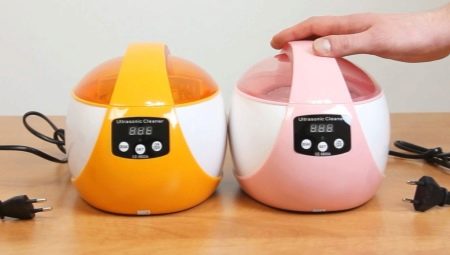There are situations when microcracks appear on the surface of a wide variety of products, in which dust and dirt get clogged over time. It is impossible to clean such impurities by any means and brushes. The situation may worsen when it comes to a fragile or valuable item, such as jewelry.
Similar difficulties arise when it is necessary to clean the internal elements of electronic devices. But it is precisely this kind of pollution in 25% of cases that causes the malfunction of technology. The way out of the situation is the use of an ultrasonic bath.
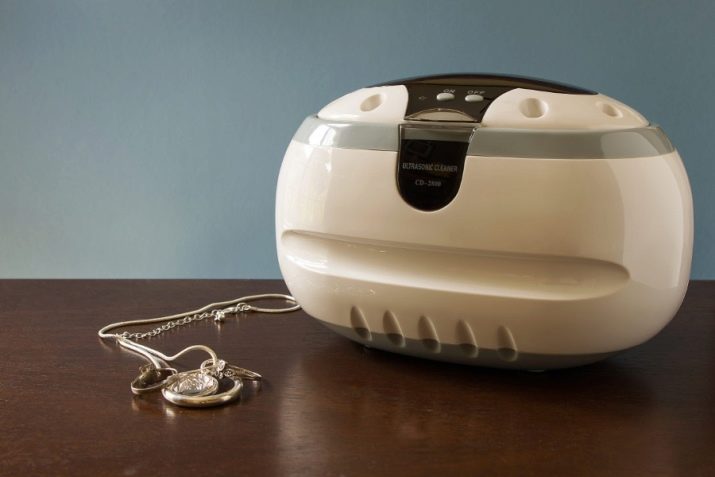
What it is?
An ultrasonic bath is a container in which ultrasonic oscillation sources are integrated. The container itself is filled with cleaning fluid. Under the influence of ultrasound pulses in the liquid, cavitation or “cold boiling” occursdue to which thorough cleaning of surfaces is possible. Cavitation is the process of the formation of a huge number of tiny bubbles generated under the influence of high and low frequency ultrasonic waves.
Faced with a contaminated surface, the bubbles burst, literally “drawing” pollution. They envelop the entire surface to be cleaned. Therefore, the removal of dirt becomes possible even in hard to reach places.
Similar designs are needed to clean the printed circuit boards of mobile phones. They often deposit dirt and particles of flux remaining after soldering.
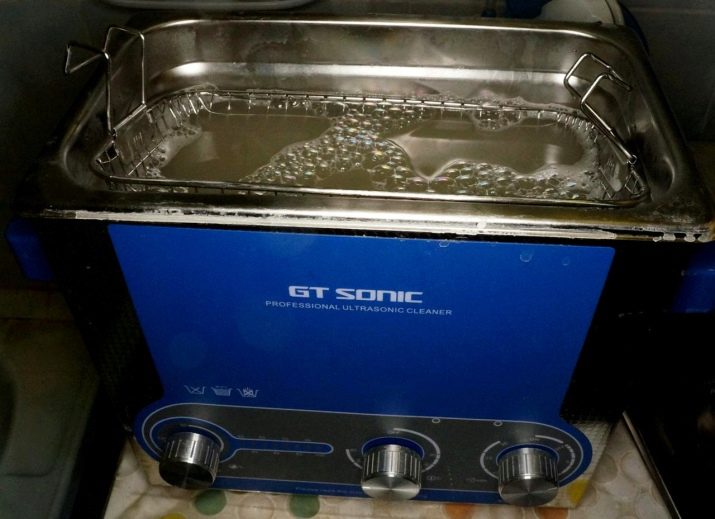
They are easily removed by ultrasonic cleaning.Jewelry made of silver and gold is also cleaned in a similar way, including with precious stones inlaid in them.
An ultrasonic bath is also useful for cleaning glasses, loops.
The popularity of the device is due to its clear advantages:
- with its help it is possible to eliminate pollution, including in hard-to-reach places;
- This cleaning method allows you to avoid damage to the surface of the subject, cracks;
- the device is universal and suitable for cleaning a wide variety of items;
- the bathtub is easy to use - it is necessary to fill in a suitable liquid and turn on the device;
- high speed of cleaning (for household use 2-4 minutes are enough).
According to customer reviews, not every device can be called effective. Therefore, its purchase, as well as the choice of the liquid used, must be done very carefully.

What is it for?
Due to its efficient and gentle cleaning, the ultrasonic bath is used in repair shops for cleaning telephone circuit boards and some other elements of electronic devices, as well as in the jewelry industry for cleaning jewelry. In the medical industry, including dentistry, the device is designed to remove contaminants from the surface of working instruments and their disinfection.
Manicurists also seek to acquire an ultrasonic bath. It guarantees high-quality cleaning of tweezers, scissors, files and other manicure devices, as well as their antiseptic treatment.
Ultrasonic bath:
- finds application in pharmaceuticals and perfumes, accelerating certain chemical processes;
- used for seed treatment before sowing;
- It is used in industry, where it is used to clean complex parts of components and mechanisms.
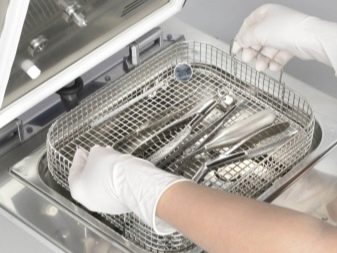

Ultrasonic cleaning demonstrates its effectiveness in getting rid of various types of contaminants.
- Pollution, in which there are no organic compounds. These include dust, soot, metal shavings. Some types of pollution penetrate the surface of the object, others form a crust on its surface.
- Organic pollution caused by exposure to the surface of the subject of lubricating, grinding compounds, coatings, grinding pastes, sawdust, metal shavings.
The device is purchased for different needs.

For cleaning nozzles
Nozzles are an electromagnetic valve designed to meter the flow of fuel or other liquid. Clogged nozzles can not cope with their functions, but cleaning them in an ultrasonic bath easily solves this problem.
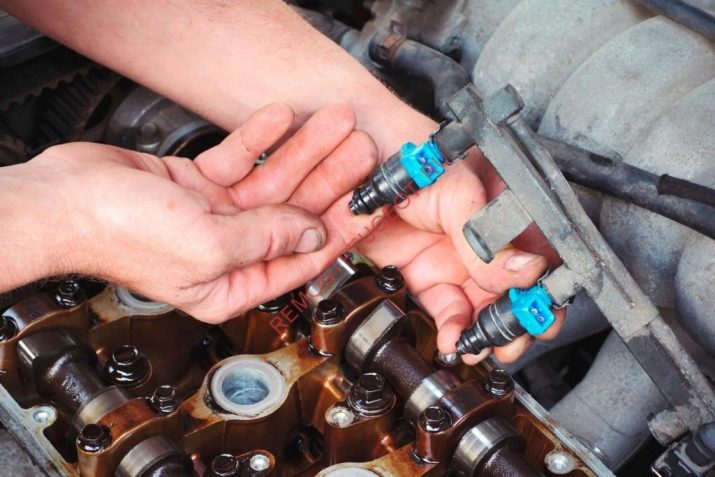
For severe contamination, low-frequency cleansing is recommended, which is repeated several times.
For washing parts
Small parts made of metal and hard alloys, optics, office equipment elements will acquire their original purity and shine, will restore their functions due to washing in the device. It can significantly increase the life of the product. However, there is no risk of damage or deformation of the parts.
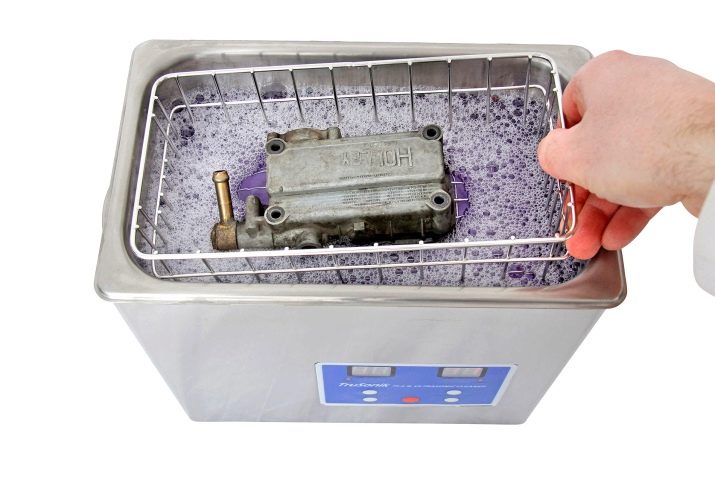
For jewelry
In the process of socks, gold and silver jewelry fade, covered with a thin film. Stones also tend to fade, lose their natural beauty. Cleaning them with ultrasound allows you to return shine and cleanliness. At the same time, even hard-to-reach elements (places of engraving, inlay of precious stones, various bends) are cleaned qualitatively. During processing, there is no risk of deformation of the product, the appearance of cracks and chips on its surface, weakening of the places of attachment of stones. In addition to cleaning, the process involves light polishing.
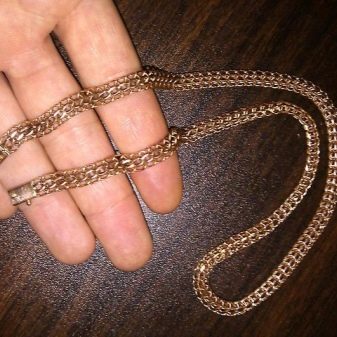
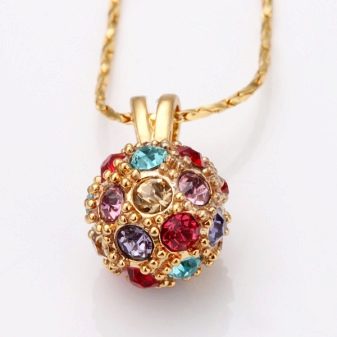
For coins
Ancient (and not only) coins are always covered with a layer of pollution, traces of patina. Ultrasound will effectively clean surfaces. It is more convenient to use a bathtub with a special strainer where coins, medals and similar items to be cleaned are put.
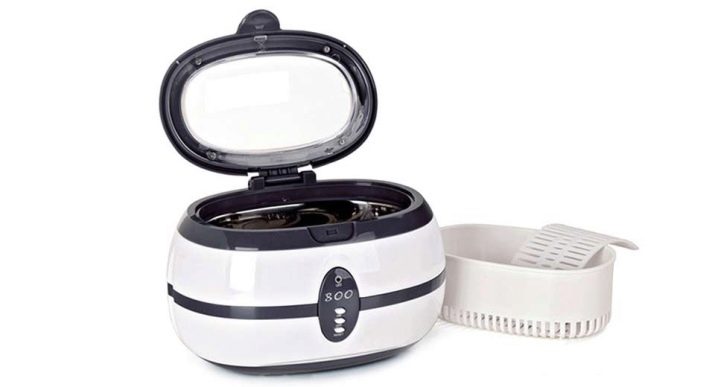
Varieties
Portable and industrial devices are distinguished depending on the volume of liquid to be cleaned. First called desktop, they have a volume of not more than 1 liter and are well established for use in everyday life and small repair shops. The tanks of most of them are made of stainless steel, which provides protection against corrosion, long-term operation of the product.
The necessary parameters (exposure time, certain operating mode) are set on the control panel, which is equipped with an external bath panel.
Industrial devices for ultrasonic cleaning have a tank volume of more than 4 liters. The most popular models are 4, 5 and 10 liters. There are devices and a larger volume. Their purpose is the purification of a large number of products, including sufficiently dimensional elements of mechanisms. Qualitative models produce heated fluid.

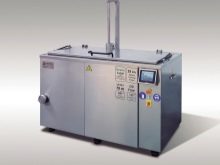
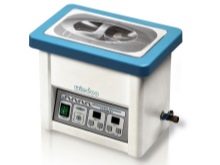
Industrial generators, in turn, are divided into 2 types:
- Low volume baths (the latter does not exceed 65-67 liters). Used in dentistry, aircraft industry (for cleaning parts), laboratories. They are equipped with heating, a cleaning fluid moving system, and a timer.
- Bathtubs of large (up to 100 l) volume. Such devices have a powerful emitter and a highly efficient generator, a circulation and filtration system of the washing liquid. Suitable for cleaning large items that have severe contamination (for example, parts of a railway train).
A mandatory element of the bath is the emitter, which performs the function of the engine, which launches ultrasonic waves. Usually it is located at the bottom or side of the device, and the oscillation frequency is 28-40 kHz. The element's task is to convert the electric energy supplied to it into the energy of mechanical vibrations of the ultrasound wave. The generator acts as a source of vibration, and a special heater provides an increase in the temperature of the working fluid to 70 degrees C and the maintenance of this parameter during the cleaning process.
The presence of a heater is an optional requirement for a complete set of an ultrasonic bath. However, if it is, the efficiency of the device increases significantly.
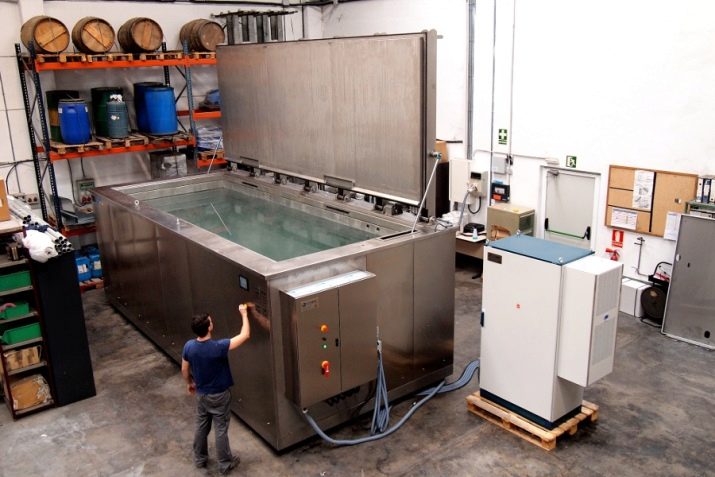
Principle of operation
Using an ultrasonic bath is quite simple.
- Pour a special liquid (concentrate) into the bowl of the working tank, place the contaminated object there, close the lid and turn on the appropriate cleaning mode. Most household models automatically start a 180-second cleanup. If necessary, the procedure can be repeated or manually select a different cleansing mode.
- For better cleaning, the item is recommended to be turned over.
- After cleaning, disconnect the device from the power supply. Only then can the object to be cleaned be removed from it.
- Then the liquid is drained from the bowl, and it is wiped and dried.
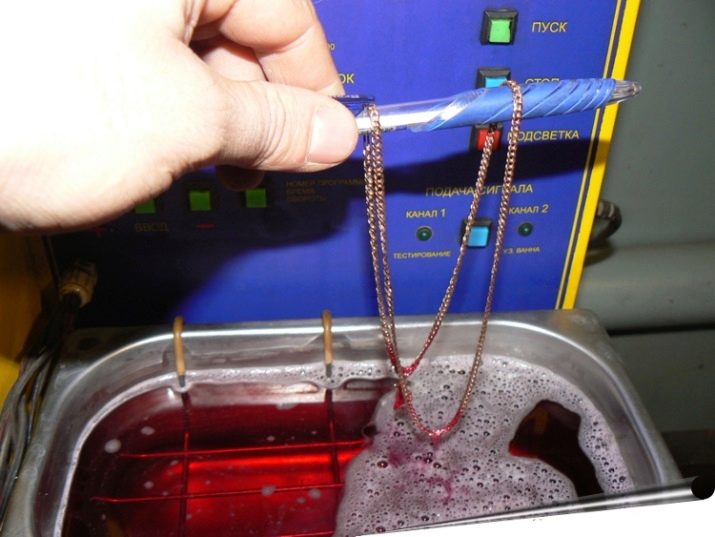
The principle of operation of the device involves receiving an electric power by the emitter and its further conversion into mechanical energy of ultrasonic vibrations. Passing through the walls of the working reservoir, electromagnetic frequencies enter the liquid, causing cavitation processes in it. As a result of this, microbubbles are formed containing steam and gas. Bubbles are injected, merged with each other, micro-shock waves are formed and, as a result, the bubbles collapse.
The pressure inside the bubble is huge, therefore, when collapsing, a large amount of energy is released. Collapse occurs at the border of a contaminated surface. The resulting energy draws dirt away from the surface. When the bath is working, a large number of bubbles are released (if the unit has a transparent cover, they are clearly visible), a buzzing sound is heard.
Manufacturers and model reviews
- Appreciation of buyers is invariably received by ultrasound production "Sapphire". The impeccable quality of components and a unique production technology are due to the cooperation of a domestic manufacturer with a leading US company for the production of ultrasonic baths. For the manufacture of models, imported components are used, at each stage of production careful monitoring is carried out. A sufficiently wide product line (22 types of devices) will allow you to choose the optimal device.
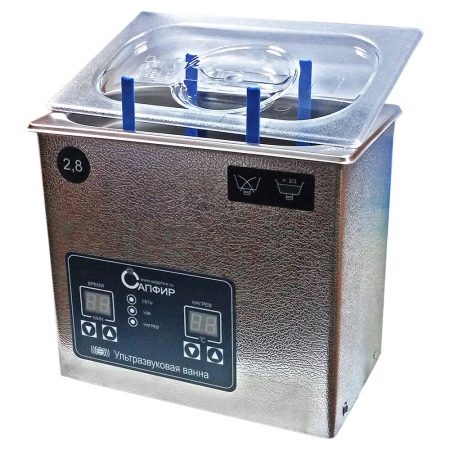
- One of the leading manufacturers of industrial devices is the company "Hail". Its assortment includes individual ultrasonic detonators and assemblies that are part of the production lines for the complete cleaning and drying of parts. Models are equipped with a circulation and fluid purification system. They have drying chambers, systems to protect the device from overheating.
- Ultrasonic bathtubs of a trademark "Tack" differ in a wide model range and include devices from 1.3 liters to 56 liters. Users note the uniform distribution of the effects of cavitation. This provides prompt and high-quality cleansing (complex contaminants are removed in 1-2 sessions). They have a splash shield, they are durable.
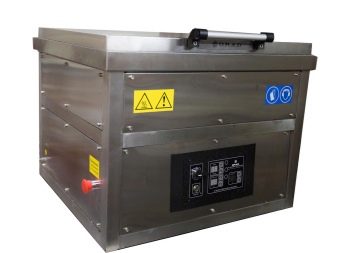
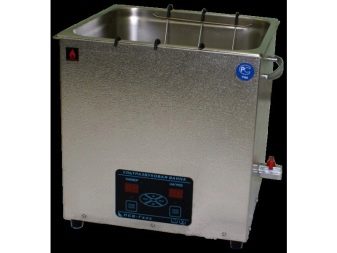
- For cleaning and primary disinfection of dental, cosmetic and manicure instruments, the unit of the company is recommended UltraEst. The ergonomics of the device, the volume of the bowl, equal to 150 ml, the economical liquid flow rate and several operating modes are the distinguishing features of the device that determine its popularity.
- A compact bath can be recommended for domestic use. Skymen. Users note the presence in the kit basket for cleaning jewelry or coins, a special rack for cleaning watches, chains. Most models have a transparent window in the panel, 3-4 operating modes.
- Brand Appliances Appreciated by Customers Triton Ultra (150x70), Elma (industrial model Elmasonic). They are distinguished by decent quality and affordability.
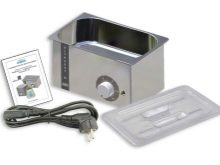
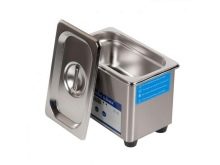
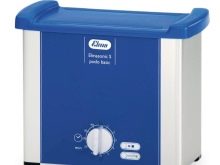
Fluid selection
An essential component of an ultrasonic bath is a cleaning solution. An effective, safe and universal remedy is distilled water. However, it is not always able to cope with severe pollution, therefore, it needs amplifiers. For example, to clean excessively soiled jewelry, the solution may be 10% window cleaner, the rest being distilled water.
Cleaning of telephone cards is carried out using ethanol.
It is not permissible to use flammable liquids as a cleaning agent. However, many neglect this rule and pour flammable liquids into the bath. By doing so, they increase the risk of fire and damage to the product. This is due to the fact that during operation the elements of the bath are heated to high temperatures. Vapors of alcohol, gasoline, solvents are concentrated near these elements, which exacerbates a dangerous situation.
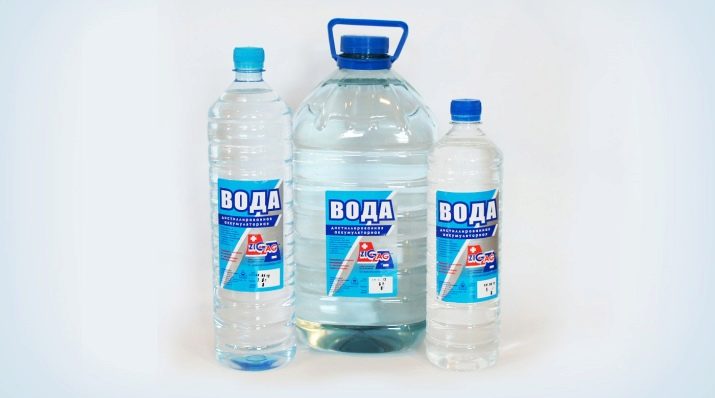
Selection tips
When buying an ultrasonic bath, decide for what purpose it is needed. The volume and power indicators of the device, its dimensions and cost will depend on this.
- To clean small parts, jewelry, coins, glasses, a small device with a volume of 1 liter or slightly less is enough.
- For washing nozzles and small parts, medical and manicure instruments, a bathtub with a volume of 1.5-2.5 liters will be optimal.
- When choosing the bowl of the device, remember that the items being washed must be completely immersed in it. In most cases, it is more rational to purchase a bath with a deeper bowl.
- The casing of the working tank must be made of stainless steel. Only in this case, ultrasonic pulses reach the cleaning fluid, and the tank itself will be protected from corrosion.
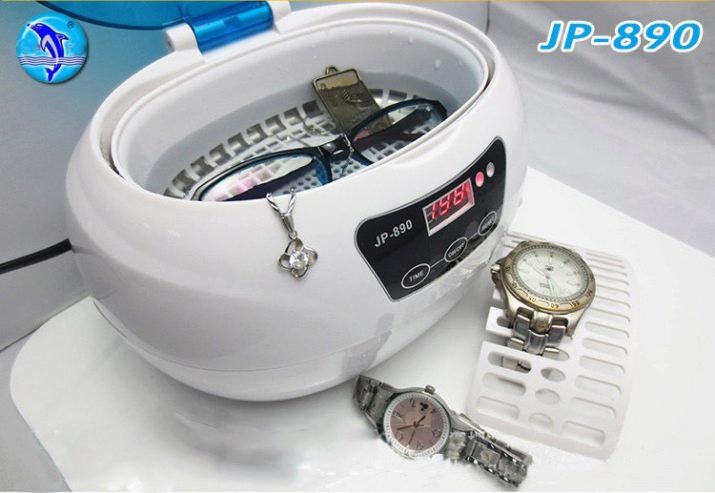
- If the device breaks down, its case must be opened, check the contacts. A failed emitter can be replaced. However, this process is quite costly from a financial point of view.In most cases, it’s easier to purchase a new device. If the product has not yet reached the warranty period, you cannot open it, you should contact the service center or the place of purchase of the bathtub.
You can learn about the principles of operation of ultrasonic baths from the video material.
